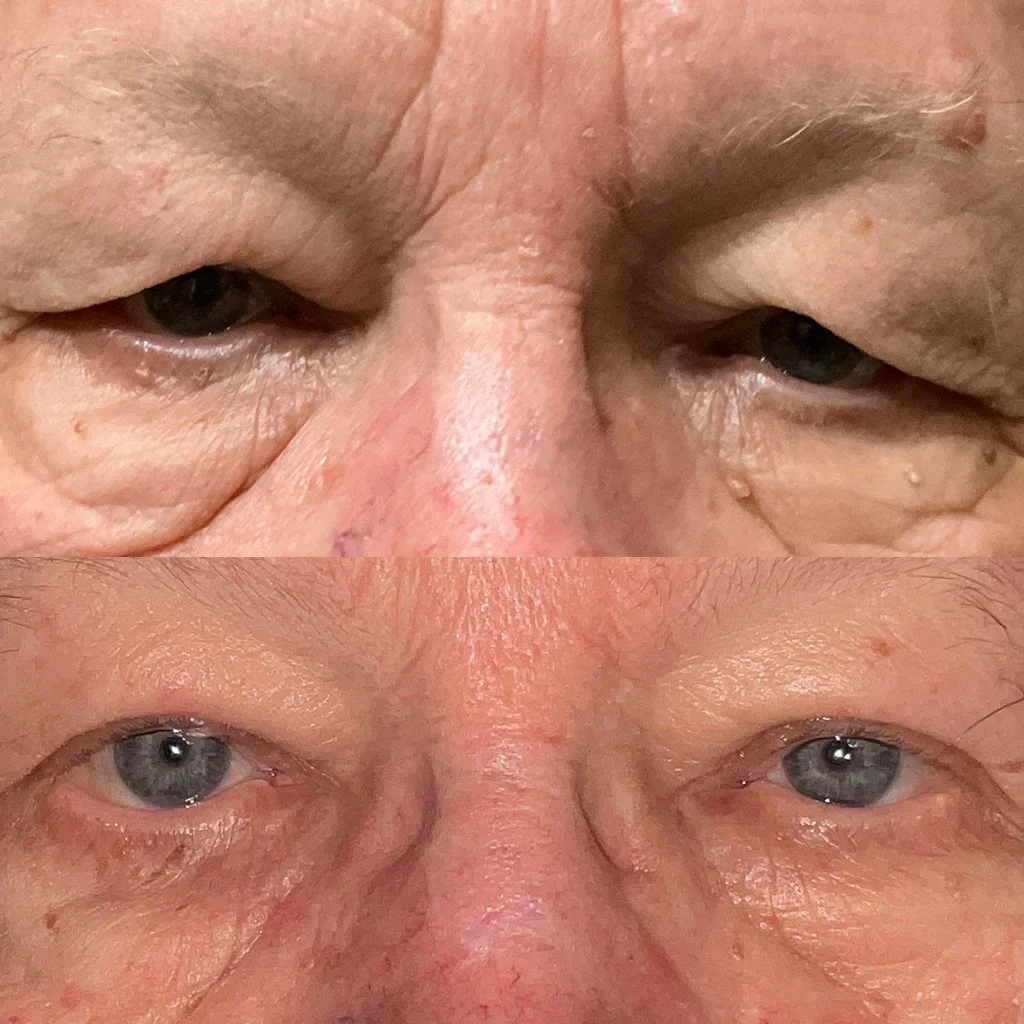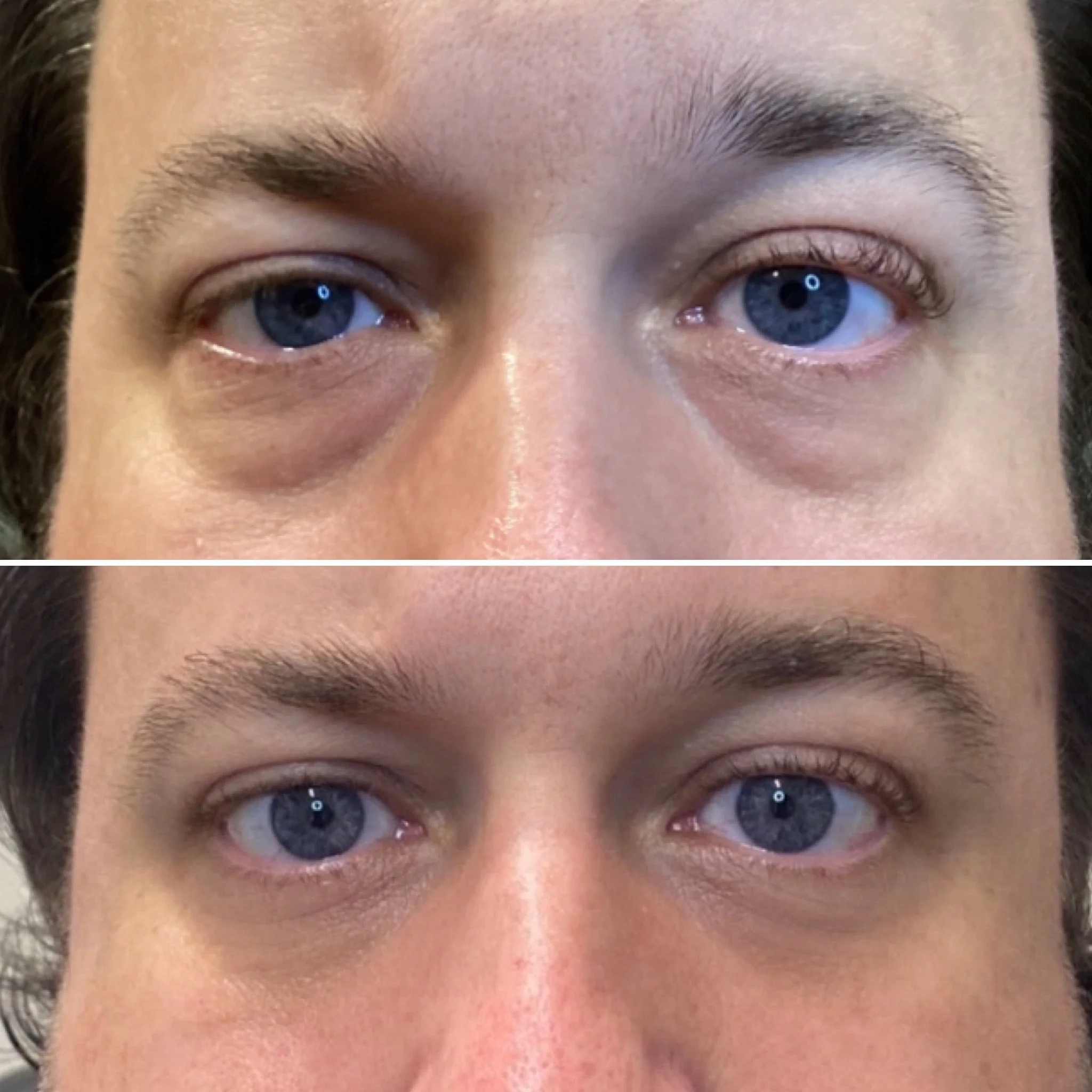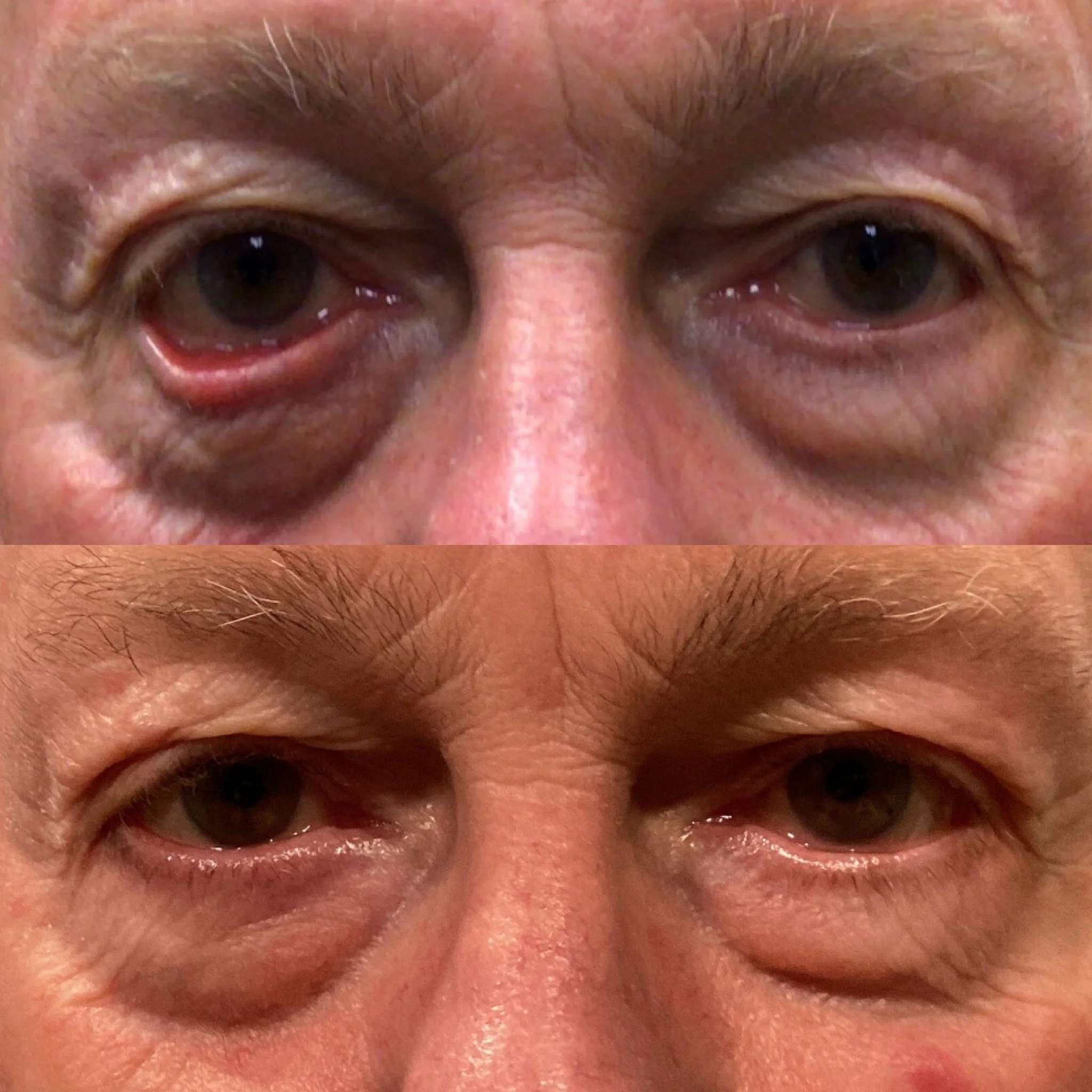Procedures
Upper Eyelid Blepharoplasty
Over the course of time, there is a natural progression in which the skin and adipose tissue of the upper eyelid may undergo sagging, contributing to an undesired and fatigued appearance. An upper eyelid blepharoplasty is a procedure in which the surplus skin is carefully removed through a discreetly positioned incision nestled within the inherent eyelid crease.
This surgical intervention not only removes the sagging tissues but also reinstates a more youthful and revitalized appearance to the eyes and face. This procedure also commonly alleviates the sensation of heaviness on the eyelids and improves peripheral vision.
Careful evaluation is essential in determining the precise amount of skin to be excised and in crafting the optimal eyelid contour. Dr. Palileo approaches each case as a unique artistic endeavor, offering a personalized experience that enhances the inherent beauty and distinctive features of each individual.
Lower Eyelid Blepharoplasty
The presence of under-eye "bags" and dark circles can give the impression of increased fatigue, irrespective of age or the amount of rest obtained. Various factors contribute to these issues, including excess skin, tissue, and tendon laxity, fat pad herniation, fluid accumulation, and skin hyperpigmentation. Additionally, health conditions like allergies, sinus disease, and thyroid disorders may exacerbate the appearance of under-eye bags. Addressing these diverse factors necessitates a personalized treatment approach, which may involve both non-surgical and surgical methods.
Individualized plans are crucial since each patient's situation is unique. Surgical procedures typically involve creating incisions on the inside of the lower eyelid to release and reposition prolapsed fat pads. In cases where excess skin is present, a discreet incision along the lower lashes allows for excess skin removal and skin tightening, with the resulting mark becoming nearly imperceptible when fully healed.
It is essential to recognize that despite surgical intervention, fine lines and wrinkles, particularly during smiling, may persist. These residual concerns can be further addressed through resurfacing techniques and the use of neuromodulators such as Botox. Fluid accumulation, often referred to as "malar festoons," may be linked to issues with the underlying lymphatic drainage system. Correcting this concern may require additional interventions beyond lower eyelid blepharoplasty, such as surgical excision or other non-invasive modalities.
Ptosis
Ptosis is a condition marked by the drooping of one or both upper eyelids. It often results from natural aging changes resulting in the stretching of the tendon and/or muscle that holds the eyelid up. In patients with ptosis, the eyelid lifting muscle needs to work harder to lift the eyelids, resulting in symptoms such as eyelid and forehead muscle fatigue and a sensation of eyelid heaviness. Less common causes of ptosis include trauma, nerve or muscle damage, previous eyelid surgeries, infection, and systemic diseases like stroke, tumors, and thyroid disorders.
Dr. Palileo employs a precise approach to correct ptosis, determining the correct surgical approach based on the patient’s individual anatomy and clinical history. The external approach involves an incision in the upper eyelid crease, providing access to the muscle and tendon. If there is no existing eyelid fold, one can be created during the incision. Alternatively, the internal approach places the incision on the inside of the upper eyelid. Dr. Palileo will review your tailored treatment plan during your consultation visit.
Brow lift
Brow ptosis refers to the drooping of one or both eyebrows, leading to a downward droop of the upper eyelid skin that may potentially obscure the eye. This phenomenon can result in a tired, sad, or angry appearance, and also leads to symptoms such as forehead fatigue and eyelid heaviness. In some instances, peripheral vision may be compromised.
Underlying medical causes of brow ptosis include nerve or muscle damage from trauma, prior surgery, infection, masses, and systemic diseases. For mild cases, Dr. Palileo may consider interventions such as Botox injections to enhance the aesthetic of droopy brows. However, surgical intervention is often the best way to elevate and stabilize the brow's position for a more long-lasting correction.
During surgery, Dr. Palileo selects the incision location directly above the brow or behind the hairline to access the muscles and tendons effectively. In certain cases, a surgical telescope may be employed through small incisions behind the hairline to lift the brow, offering a minimally invasive approach to achieve the desired correction.
Entropion Repair
Entropion is a condition characterized by looseness of the eyelid tendons and muscles, causing the eyelid to rotate inward. This inward rotation of the lid results in the eyelashes rubbing against the eye. This constant friction can cause the eye to become red, irritated, and watery. In severe cases, the repeated rubbing of eyelashes against the eye may lead to corneal abrasions, ulcers, scarring, and, in extreme situations, permanent vision loss.
Surgical correction of entropion is imperative to restore the eyelid to its proper position. Dr. Palileo typically employs a comprehensive approach that includes horizontal eyelid tightening and reattachment of loose eyelid muscles, ensuring optimal realignment and minimizing the risk of recurrence. This intervention is designed to alleviate symptoms, prevent further complications, and preserve the long-term health and vision of the affected eye.
Ectropion Repair
Ectropion is a condition characterized by the looseness of the eyelid tendons and muscles, leading to an outward rotation of the eyelid. This rotation causes the lid to turn away from the eyeball, causing irritation by failing to retain tears against the eye. The affected lid may become red and thickened, contributing to the overall discomfort of the eye. In some instances, the eyelid is pulled away from the eye due to a deficit of skin (known as cicatricial ectropion) resulting from factors like prior sun damage, skin cancer removals, radiation, trauma, or surgery.
Ectropion repair surgery is crucial for reinstating the eyelid to its correct position. Dr. Palileo adopts a strategy, commonly involving horizontal eyelid tightening and the reattachment of loose eyelid tendons muscles if needed. This approach is designed to achieve optimal realignment while minimizing the likelihood of recurrence. By addressing these issues, the intervention aims to relieve symptoms, prevent additional complications, and safeguard the long-term health and vision of the affected eye.
Chalazion (Stye)
The appearance of an inflamed nodule on the eyelid may be due to an obstruction of the oil glands present along the eyelids. This is referred to as a chalazion, or more commonly, a stye. Underlying medical conditions such as blepharitis or rosacea, the use of eye makeup and false lashes, and frequent touching of the eyelids (exacerbated by allergies and environmental irritants) heighten the risk of developing chalazions.
Dr. Palileo promotes a thorough and expert approach to tackle these issues. Conservative treatment measures include frequent warm compresses, along with topical eye drops, and possibly oral antibiotics. In cases where necessary, intralesional injections of steroids may be recommended to promote resolution. Surgical incision and drainage may be considered if the chalazion does not respond adequately to medical therapy, with Dr. Palileo ensuring that the chosen intervention aligns with the patient's individual needs and circumstances.
Blepharospasms / Hemifacial Spasms
Blepharospasm involves the excessive and involuntary closing of both eyelids. Although usually harmless, it can sometimes be linked to broader health issues or syndromes. People experiencing blepharospasm may report discomfort in the eyes, inflammation of the eyelids (blepharitis), and sensitivity to light.
On the other hand, hemifacial spasm is characterized by involuntary contractions affecting the muscles innervated by the facial nerve. This condition manifests as one-sided spasms around the forehead, brow, eyelid, cheek, and mouth. Hemifacial spasms can happen when the facial nerve becomes compressed, possibly due to a mass or enlarged blood vessel in the brain. Other reasons can include conditions like Bell's palsy, as well as issues related to blood flow, compression, or damage to the nerve, which can result from injuries or surgeries.
Dr. Palileo provides personalized Botox treatment plans designed to alleviate blepharospasm and hemifacial spasms, offering patients relief. This non-invasive treatment regimen works by easing involuntary muscle contractions, allowing you to regain control and experience more comfort in your daily activities.
Cosmetic Neurotoxin Injections (Botox®)
Botulinum toxin injections offer a minimally invasive solution to reduce the appearance of fine lines and wrinkles by temporarily relaxing or weakening muscles. Botulinum toxin injections primarily treat "dynamic wrinkles," which are lines that result from facial movements. In contrast, "static wrinkles" are lines that are present at rest. While consistent treatment with botulinum toxin injections may contribute to the softening of static wrinkles, it's important to note that complete resolution may not always be achieved. Treating dynamic wrinkles early is important to prevent them from becoming static.
Botulinum toxin injections can address various concerns such as crow's feet, under-eye jelly rolls, forehead lines, glabellar lines, minor brow drooping, lip lift, TMJ (temporomandibular joint) or masseter hypertrophy, and hemifacial spasms/blepharospasms. Determining the necessary amount of botulinum toxin is contingent on the treatment area and individual requirements. Dr. Palileo focuses on attaining the most natural appearance for every patient.
Eyelid lesions and Eyelid Cancer Reconstruction (Mohs Reconstruction)
Various benign growths, including skin tags, moles, freckles, and cysts, can grow on the eyelids. However, it is important to recognize that about 5-10% of skin cancers can occur in the eyelid. For a comprehensive assessment of eyelid bumps or lesions, it is crucial to consult with an eyelid specialist like Dr. Palileo. In situations where a lesion raises suspicion of potential malignancy, Dr. Palileo may suggest a biopsy to determine the nature of the growth.
In cases of a confirmed malignancy diagnosis, Dr. Palileo performs excisional biopsies followed by reconstructive surgery. In some cases, collaboration with a Mohs surgery-specialized dermatologist may be coordinated, potentially scheduled on a separate day. The choice of reconstruction techniques depends on the size and location of the resulting eyelid defect. Reconstructive surgery may involve multiple stages to attain the best possible aesthetic and functional results for every patient.
BOOK AN APPOINTMENT
Want to make a booking or have a question?
Call us at 425-454-7912 or simply contact us








